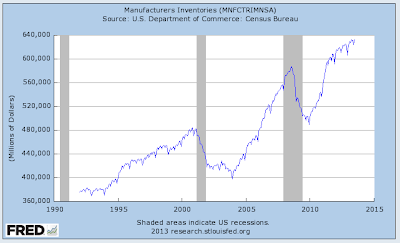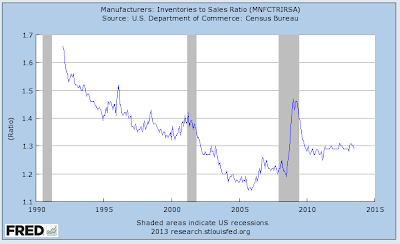Somehow, this recovery feels different. Employment is stagnant and real economic growth is practically non-existent compared to normal recoveries. In this posting, I'd like to take a look at an economic metric that is rarely discussed; manufacturers inventories and sales and their impact on manufacturing employment.
Here are a couple of charts that show why this recovery has been stagnating:
The first chart shows manufacturers' inventories in millions of dollars. Inventories, as would be expected, plummeted as the recession took hold and production levels were scaled back as sales dropped through the floor, but have risen 29 percent from their post-recession lows to their current level.
The second chart shows manufacturers' sales in millions of dollars. As expected, sales rose after the end of the Great Recession, growing by 37 percent to their current level. Unfortunately, manufacturers' sales have stagnated in a fairly narrow range since March 2011, growing by only 6.6 percent in just over three years. This growth pattern is far different than what was experienced after the 1990 – 1991 and 2001 recessions where manufacturers' sales kept rising right through to the next recessionary period. It is even more shocking given that sales dropped by a staggering 28 percent over a nine month period during the Great Recession, far in excess of the 10.1 percent drop during the 2001 recession. One would think that a huge retrenchment in sales during the Great Recession would be followed by a long period of robust sales growth, however, that clearly has not been the case, particularly over the past three years as I noted above.
Now, let's look at the combined data in the form of the ratio of inventories to sales, keeping in mind that a low ratio (i.e. a ratio of 1.0) means that all inventory is being sold and a high ratio means that less inventory is being sold:
The normal post-recession inventories to sales data after the 1990 – 1991 and 2001 recessions showed a steady decline in the ratio, meaning that manufacturers' inventories were drawn down at the same time as sales rose. This allowed manufacturers to hire more workers and increase output to meet increasing demand. Such has not really been the case in this recovery; certainly the ratio fell within the first few months after the end of the recession but, since September 2009, just months into the recovery, the ratio has been stuck at between 1.25 and 1.30 with no sign of dropping further. This is quite a bit higher than the level seen just before the Great Recession, meaning that manufacturers' inventories simply aren't being consumed as they normally would. It is also the only time in the last three recessions that the inventory to sales ratio has not dropped steadily as the recovery took hold.
The relatively poor sales performance by the manufacturing sector has led to this:
Note that the number of Americans employed in the manufacturing sector is now at levels not seen since the early 1940s when the population of the United States was around 135 million people, 43 percent of today's population.
Let's look more closely at the period from 2000 to the present:
Just before the Great Recession, there were between 14.1 and 14.2 million Americans employed in the manufacturing sector. This dropped to a low of 11.47 million in December 2011, a drop of 19.2 percent. Since its nadir, the number of Americans employed in manufacturing has recovered to its current level of 11.963 million, a gain of only 493,000 jobs or 4.3 percent. This means that, despite the Fed's massive intervention in the jobs market, a significant 2.24 million American manufacturing jobs have disappeared, probably permanently. If we go back to the beginning of the new millennium, the situation looks even worse; in January 2000, there were 17.28 million Americans working in the manufacturing sector. Since then, 5.32 million American manufacturing jobs or 30.7 percent of the total have been wiped from the economy over a 13 year period.
And we wonder why this doesn't feel like a recovery? It will certainly be interesting to see what happens when the Fed's market-impacting fun and games come to an end, won't it? Sadly, with companies showing a great willingness to export jobs to overseas manufacturing facilities in an effort to prop up profits and pay bonuses to the corner office dwellers, it is highly unlikely that the Fed's policies would have ever had any impact on what was once a key sector of the American economy.
Click HERE to read more of Glen Asher's columns
You can publish this article on your website as long as you provide a link back to this page.






Be the first to comment